By Carolyn O. Arguillas MindaNews and Philippine Center for Investigative Journalism
MARAWI CITY (MindaNews / 18 October) — As early as September last year – while battles were still going on here — the Provincial Government of Lanao del Sur and the Marawi City government had submitted a Joint Recovery, Rehabilitation, and Peacebuilding Plan not only for the country’s only Islamic city, but also for the affected towns in Lanao del Sur.
With the Plan received by Task Force Bangon Marawi (TFBM), the hundreds of thousands of Marawi residents displaced by the conflict waited for feedback, if not for any announcements of specific steps to be taken in order for their city to rise again.
Today they are still waiting. Indeed, more than a year later, no one knows for sure how many components of that joint blueprint ever made it into the national government’s Bangon Marawi Comprehensive Rehabilitation and Recovery Plan (BMCRRP).
Says Acram Latiph, an economics professor at the Mindanao State University (MSU) who was among those who helped put together the Marawi-Lanao del Sur proposal: “Yung final plan wala kamingaccess kaya ‘di ko talaga alam ano na kinalabasan ngCRRP (We don’t have access to the final plan that’s why we do not know what CRRP ended up as).”
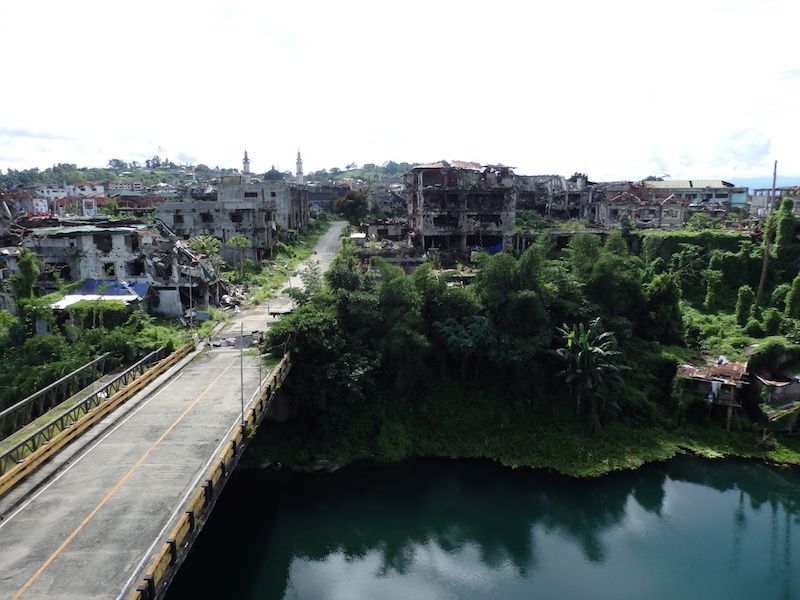 Ground Zero, Marawi City, 16 October 2018.. MindaNews photo by CAROLYN O> ARGUILLAS
Ground Zero, Marawi City, 16 October 2018.. MindaNews photo by CAROLYN O> ARGUILLAS
This is even though last March 20, Undersecretary Adoracion Navarro of the National Economic and Development Authority’s (NEDA) Regional Development Office finally gave some local residents and officials a glimpse – their first — of the BMCRRP.
Navarro gave her presentation at a multisectoral forum held at the provincial gym. Using Powerpoint, she explained that the BMCRRP has a two-pronged approach: the CRRP, which shall include “programs and projects to be located outside of the most affected area” and Executive Order No. 49, which shall “guide the reconstruction process of the Most Affected Area through a joint-venture scheme.”
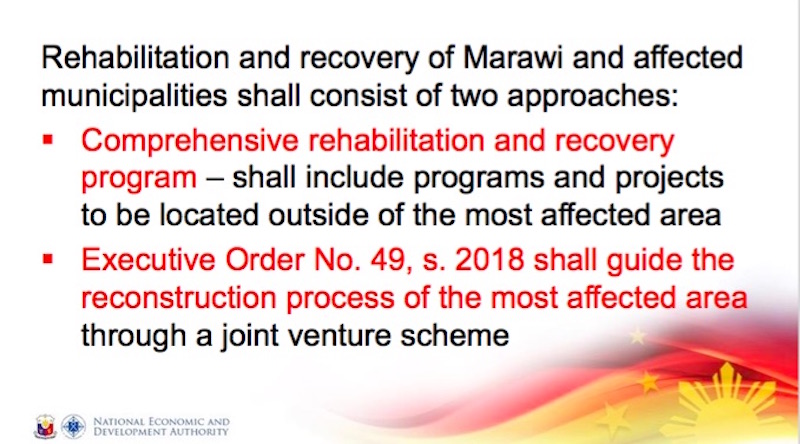 The two-pronged approach for the rehabilitation, recovery and reconstruction of Marawi, according to the NEDA presentation in Marawi on 20 March 2018
The two-pronged approach for the rehabilitation, recovery and reconstruction of Marawi, according to the NEDA presentation in Marawi on 20 March 2018
The “Most Affected Area” is otherwise known as Ground Zero or the 24-barangay area at the heart of the city that suffered the most destruction during the siege.
E.O. 49, issued by President Duterte on February 5, meanwhile exempts the National Housing Authority (NHA) from NEDA guidelines on joint-venture agreements supposedly “to expedite the implementation of recovery, reconstruction and rehabilitation projects in the most affected areas of Marawi City.”
People kept in the dark
Based on Navarro’s presentation, the BMCRRP would cover the rest of the city’s 96 barangays while the MAA would be under another plan “guided” by E.O. 49.
The two-day forum had been organized by the provincial government in response to growing complaints from the city’s displaced residents who wanted to know what was going on. The residents felt that they were being kept in the dark as to what was being planned for Marawi and other affected towns in Lanao del Sur, such as Butig and Poona Piagapo.
In his opening remarks at the forum, Lanao del Sur Vice Governor Mamintal Adiong had declared, “Hanggang ngayon, wala pang napre-present ang TFBM naconcrete rehab plan (Until now, the TFBM has yet to present a concrete rehabilitation plan).”
Task Force Bangon Marawi or TFBM is an inter-agency body created by President Duterte in June last year through Administrative Order No. 3 for the “recovery, reconstruction, and rehabilitation of the city of Marawi and other affected localities,” referring to the previous battlegrounds of the warring forces in Butig and Piagapo towns in Lanao del Sur. Notably, the Task Force was created a month and five days into what would turn out to be a five-month war.
It has been primarily the Task Force that has been updating the public on what the national government is planning for Marawi. But the “updates” have not really strayed far from promises about building a “new” and “better” Marawi, along with announcements about groundbreaking ceremonies that keep on getting postponed, and budget estimates that change every time the Task Force head speaks.
At the March multisectoral forum, TFBM chairman Eduardo del Rosario did present several slides showing the “development perspective” of the future Marawi: a Marawi with a lakeside promenade, cultural center, resorts, hotels, convention centers, a city green, and an eco-corridor, among other things.
Yet while the artistic renderings of TFBM’s vision of the “new Marawi” were impressive, several participants wondered aloud: “Where is the Meranaw there? Whose perspective is this?”
Unanswered queries
Ground Zero residents were more concerned about answers to questions that had been bothering them since they fled their villages in late May 2017. For example: Can they go back to the land where their homes or shops were built? What about compensation, reparation for the destroyed buildings, as well as for the furniture, cash, jewelry, and other things that had gone missing? And why build another military camp? What is the status of their ancestral lands vis-a-vis the military reservation? What about the shelters for displaced residents?
Displaced residents complained to del Rosario at the forum that no multisectoral consultations had been done before that meeting at the gym. Not content with that, weary Meranaws decided to bring their message directly to the President through an open letter on March 29 and a prayer march-rally the next day.
In its letter to the President, the Ranaw Multi Sectoral Movement (RMSM) said that the future “seems threatening.”
“Forces are moving that threaten to do far greater damage to our people than what the war has done,” it continued. “The bullet-riddled, crumbling remains of the Grand Masjid in our beloved Marawi, silent as it is now and absent of prayers, cries out. For in the guise of rebuilding our home, in the guise of laying down the foundations of a better, progressive and modern city, the will and vision of those who live far from us who built this city are being imposed upon us. This is an invasion of a different kind. This one threatens to rob our soul.”
RMSM lamented that “plans have been made without our participation… that neither bear the stamp of our will nor reflect our culture… whose mechanics and implementation are not clear to us.”
“But one thing is clear: the people of Marawi are largely left out,” it said. “Those who came to present the plan dismissed our comments, recommendations, and protestations as though we knew nothing and have no business getting involved in rebuilding our very own city.”
The RMSM asked Duterte, who claims Meranaw roots, to “grant us, the people of the lake, the rightful heirs to this land, our right to rebuild this city with your guidance, support and protection.”
“We appeal to you to let Marawi be rebuilt the way our ancestors did: one house at a time, one masjid at a time, one village at a time,” it said. The Movement also urged the President to stop the proposed ecozone and military camp plans “until we have been heard, until our dreams and aspirations, our cultural sensitivities and our faith find expression in the rebuilding of Marawi City, our home. This is the cry of our people. This is the cry of Marawi.”
Wept, wailed, prayed
Last March 30 – Good Friday for Christians, Holy Friday for Muslims — two days after the letter-appeal was sent out, Meranaws from various sectors attempted to march to Ground Zero to hold a congregational prayer at the Grand Mosque itself and at the same time pray for those who died in the conflict. The war had left some 1,000 dead, including at least 47 civilians.
But a phalanx of male and female police personnel as well as soldiers stationed at Rapitan (formerly Pumping) Bridge barred the Meranaws entry into Ground Zero. So they laid down their prayer rugs on the road for their congregational prayers and rites for relatives who perished in Ground Zero during the five-month siege.
Men and women wept and wailed openly, their prayers at times drowned out by the sound of sorrow.
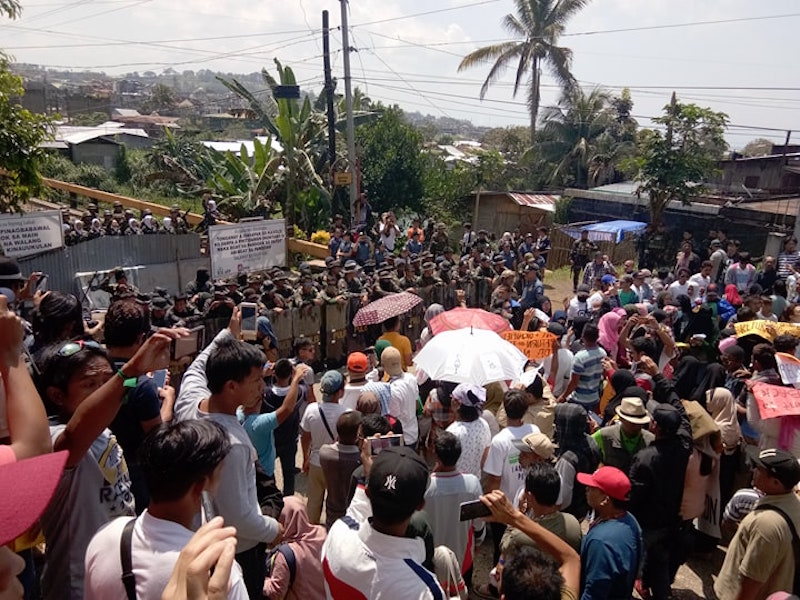 Displaced Marawi residents who participated in the “M’balingan Tano sa Ground Zero” on Friday, March 30, 2018, reach Rapitan Bridge (formerly Pumping Bridge) en route to Banggolo in Marawi City but were barred from proceeding to Ground Zero. Photo courtesy of ASMIN A. MONIB / Ranao Rescue Team
Displaced Marawi residents who participated in the “M’balingan Tano sa Ground Zero” on Friday, March 30, 2018, reach Rapitan Bridge (formerly Pumping Bridge) en route to Banggolo in Marawi City but were barred from proceeding to Ground Zero. Photo courtesy of ASMIN A. MONIB / Ranao Rescue Team
Rally organizers had earlier planned a march to Ground Zero from Kilometer Zero near People’s Park, passing through City Hall compound to Pumping Bridge to Banggolo and finally to the Grand Mosque or Islamic Center for the prayers.
But no permit was granted by the military, which has jurisdiction over Ground Zero.
“This is not liberation, this is occupation,” says MSU history professor Tirmizy Abdullah. He points out that “liberation” does not resonate with Meranaws, particularly those in Ground Zero who cannot as yet return home and who cannot even enter their villages without the military’s permission.
Apparently in response to complaints from Marawi residents that they were not consulted on the rehabilitation of Marawi, TFBM with assistance from the World Bank last April conducted Suwara Marawi (Voice of Marawi), in 30 focus-group discussions involving 980 participants in the cities of Marawi, Iligan, the towns of Saguiaran and Pantar in Lanao del Sur, Balo-i in Lano del Norte and Initao in Misamis Oriental.
Agreements, disagreements
Findings of the FGDs, like the Post-Conflict Needs Assessment (PCNA), Damage and Loss Assessment (DALA), BMCRRP and MAA Rehabilitation Plan, have not been made public. But according to insiders who have seen copies of the Suwara Marawi Executive Summary, the report states that the participants were “nearly unanimous in their opposition to the establishment of (an) additional military camp in the area.”
The report also supposedly notes other agreements and disagreements to the proposed MAA development plan, among them the expansion of the road to four lanes as three lanes would be acceptable.
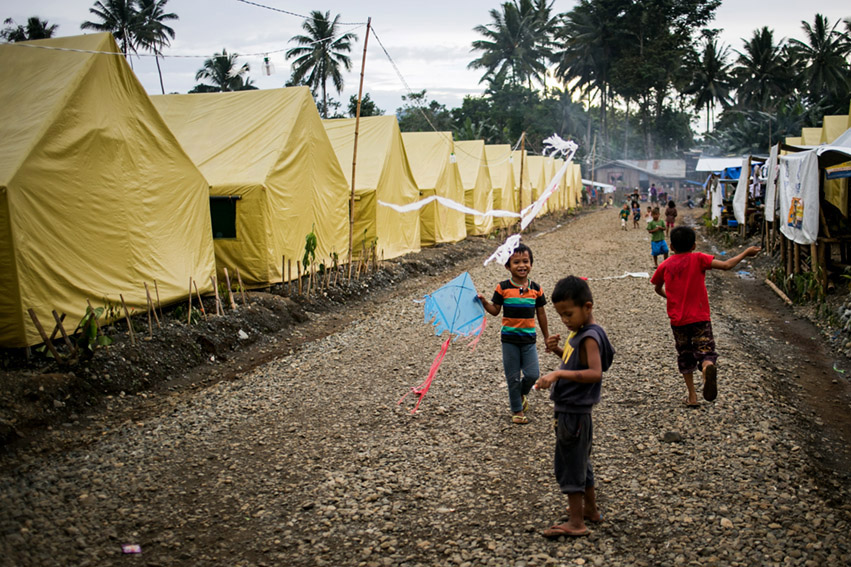 Children play kites inside the Tent City in Pantar, Lanao del Norte. 20 Septeber 2017. Manman Dejeto
Children play kites inside the Tent City in Pantar, Lanao del Norte. 20 Septeber 2017. Manman Dejeto
The PCNA was supposed to have included a Human Recovery Needs Assessment in August 2017, DALA from September to December 2017, and Social Healing and Peacebuilding Assessment in November 2017.
The BMCRRP, meanwhile, was approved by President Duterte last June. According to NEDA’s Navarro, the BMCRRP by then had atotal of 744 priority Programs, Projects, and Activities (PPAs), down from the 902 listed in its April 12, 2018 version.
No specific plans yet
The PPAs have been classified under six sectors: Local Governance and Peacebuilding, Housing and Settlement, Livelihood and Business Development, Physical Infrastructure, Social Services, and Land Resource Management.
Proposed projects and activities have been listed, but since copies of the BMCRRP have not been made public, monitoring its implementation is a challenge.
TFBM Field Office Manager Felix Castro has been pushing for the establishment of a Project Monitoring Office and a Management Information System to track down the progress — or lack thereof — of the PPAs.
Castro says that the establishment of the PMO and MIS is ongoing, and that the Task Force has partnered with civil-society groups in Marawi to help them in the monitoring process.
For now, Castro can quickly answer questions on the number of transitory and permanent shelters constructed, but is candid enough to say “I cannot answer that” when asked about the progress of “Bangon Marawi” in the other sectors.
Officials of Marawi and Lanao del Sur have yet to see a copy of what is supposed to be, according to del Rosario, a “voluminous” BMCRRP. Little has been heard as well about specific plans for the MAA.
Based on NEDA and TFBM statements, though, Marawi would need about PhP47 billion for projects outside the conflict zone, about PhP17.2 billion for projects in the MAA, PhP20 billion in compensation for the properties destroyed in the siege (excluding PhP882 million specifically for mosques), and PhP1.2 billion for livelihood.
They want to go home
But Marawi’s displaced residents are getting more restless by the day. Last October 7, some displaced residents and civil-society organizations launched #LetMeGoHomeMovement through social media, calling on the government to just allow them to go home to their villages in the MAA since the rebuilding of their city is taking too long.
The Movement urges fellow Meranaws and friends to upload a photograph, either solo or group, with the message “I am from Marawi. Let me go home” in their social media accounts. Friends of the displaced are also encouraged to join in the uploading of photos with the message “I have friends from Marawi. Let them go home.”
Eighteen-year-old Faykha Khayriyyah Alonto Ala, newly elected chair of Barangay South Madaya Proper, says that there have been “too much grand plans, plans that clearly do not have any direction.”
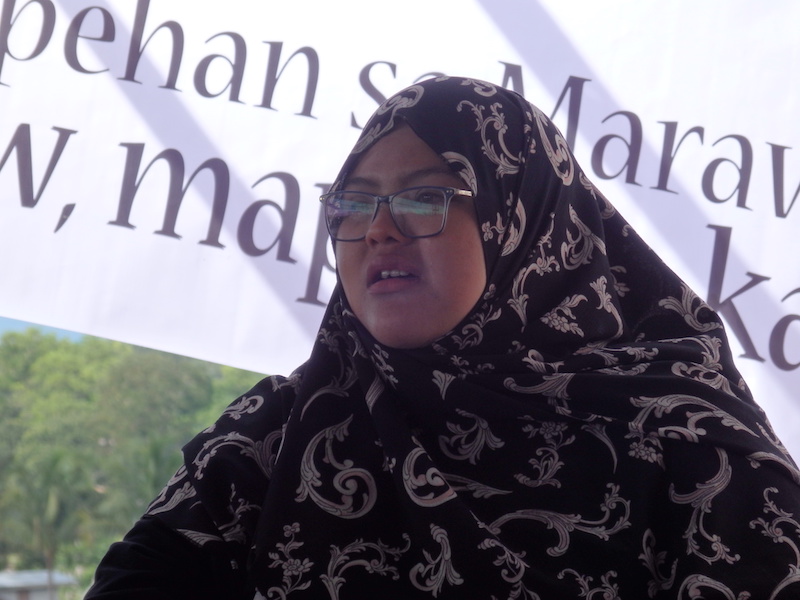 Faykaha Alonto Ala reads the open letter to President Rodrigo Duterte on 16 October 2018, urging him to let them go home. MindaNews photo by CAROLYN O. ARGUILLAS
Faykaha Alonto Ala reads the open letter to President Rodrigo Duterte on 16 October 2018, urging him to let them go home. MindaNews photo by CAROLYN O. ARGUILLAS
“Let us keep it simple,” says Ala, who like the barangay chairpersons in the 23 other villages in Ground Zero, has yet to come up with ways on how to serve her dispersed constituents. “Grant the people their rights to their properties, help them rebuild their lives in the way they want, just our old Marawi, our home.”
On October 16, at the top floor of the bullet-peppered five-story Al Farabi International School overlooking Ground Zero, Ala read the open letter of ‘Marawi is Ours, Let Us Go Home Movement’ to President Duterte: “Mr. President, we are your people too. Please, let us go home!”
As she spoke, some of those listening to her wiped away their tears quietly, while those who were looking at the ruins of Marawi scanned the horizon from the bridge in Banggolo, for landmarks they could still identify to guide them, mentally, to where they used to live until May 2017.
‘People of the tents’
“Once, we were the people of the lake,” read Ala. “Now we (have become) the people of the tents. Made to wait indefinitely. The terrible question at the back of our minds: Will we ever get back home?”
Minutes later, at the “Anyare Marawi (What happened Marawi)” rally of the Moro Consensus Group and Bangsamoro National Movement for Peace and Development, in the area called Bangon, participants brought along tarpaulins bearing these appeals to go home: “Hirap na po kami, pauwiin nyo na kami (We are already suffering, will you let us go home)?,” “Tama na! Sobra na! Pauwiin nyo na kami (Enough! Too much! Let us go home!)” and “’Yung totoo, kelan kami makakauwi(The truth, when can we go home)?”
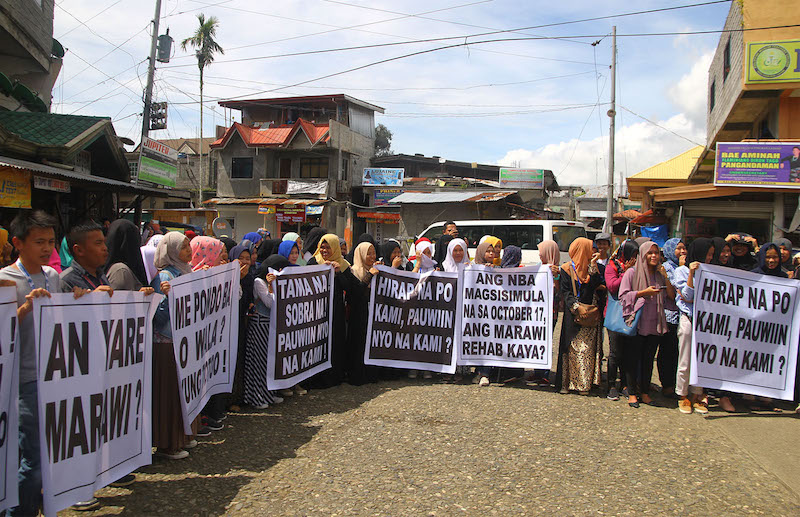 Rally participants in Marawi City on 16 October 2018 say all they want is to go back home. MindaNews photo by GG Bueno
Rally participants in Marawi City on 16 October 2018 say all they want is to go back home. MindaNews photo by GG Bueno
Lawyer Falconi Millar, Secretary General of the Housing and Urban Development Coordinating Council and head of TFBM’s secretariat, says that seeing Marawi’s residents back in their homes is exactly the aim of the Task Force.
“That is what Task Force Bangon Marawi is doing,” he says. “To bring our Maranao brothers and sisters from the MAA back to their home, safely, at the soonest possible time, and to a home that is with an environment that is modern Islamic and culturally sensitive.”
He also says that TFBM has conducted “more than 200 dialogues and will continue to conduct more to engage our Maranao brothers and sisters and to update them as developments unfold.”
TFBM, adds Falconi, “will ensure that they will come home as soon as it is safe to do so and as soon as horizontal development per sector is accomplished and as soon as doing so would not impede the rehabilitation in adjoining sectors in the MAA.”
For his part, del Rosario says, “I fully understand the sentiments of some residents in expressing their wishes.” But, he says, it is “not doable considering the magnitude of the needed rehabilitation in the entire MAA.”
“I am sure,” says the ever optimistic TFBM chief, “they will be satisfied once the whole rehab is over.” — MindaNews and PCIJ, October 2018
